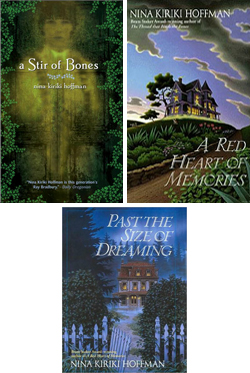I don’t know if there’s an official name for this series, but I call them the Haunted House books. I read them in absolutely the wrong order, but that’s okay, Nina Kiriki Hoffman wrote them in the wrong order, too. Internal chronological order is A Stir of Bones (2003), A Red Heart of Memories (1999) and Past the Size of Dreaming (2001). There’s also a short story that I’m sure I’ve read but can’t find which goes with them. I’ve been looking for A Red Heart of Memories for ages (though I have no idea why it was hard to find) and I managed to buy it in Reno. I’ve read it twice since then, once alone and once re-reading the series in order.
These three books are the story of a haunted house on the coast somewhere in the Pacific northwest and the children who come into that house and their lives and interactions. There’s lots of magic, and everything is alive, and they are written in a beautiful folksy way. They’re about family and friendship and they do startling things with magic. They’re remarkably original.
These are very odd books, and I’m not sure who they’re aimed at, apart from me. They read like children’s books—not like YA, nothing like YA, like old fashioned children’s books full of magic and ghosts. (One of the best characters is a ghost.) But in Red Heart of Memories and Past the Size of Dreaming the characters are grown up, though the significant events that have shaped their lives and which are central to the stories happened when they were teenagers. Besides, I say they’re grown up but they’re grown up in a strange way, almost like a child’s imagination of being grown up. None of them have children, and few of them have jobs or responsibilities that impede their daily lives. You couldn’t let a child read them though, not a young child because while there’s no more sex on the page than a kiss or a cuddle there’s a lot of background child abuse—two of the major female characters have been abused. They are like children’s books that go into the unspeakable things fairytales imply but do not explore. I suppose they are books for ex-children, as Firebird editor Sharyn November puts it.
They are not much like fantasy. I’ve said about Hoffman before that her books remind me of Zenna Henderson, which is true, but not these. There’s a way of integrating magic into stories which is typical of fantasy—there’s a whole sheaf of ways of doing it, but they are all taxonomically related. I call it “realist magicism.” The thing with fantasy magic is that you think about how it affects the world and what the consequences are and how it all fits together. It’s a very science fictional way of looking at magic, though Tolkien did it, too. But Hoffman isn’t doing this here at all. She’s interested in a different set of questions. She doesn’t care about it making logical sense in a science fiction kind of way (granted that there is magic and it works like this then therefore —) she’s far off at the other end of the scale where things make poetic and emotional sense. If you’re asking how it works then you’re reading it wrong.
There are some awesome things in these books. There’s Julio’s mother, Juanita, whose reactions both to Susan being abused and to her son sharing his body with something that used to be a demon are terrific. (We don’t hear how she deals with Julio’s sex change, but I expect she takes it in her stride.) There’s Matt, who has conversations with benches and cars and clothes and occasionally even people. There’s Dee, who was the one who never got magic although all the others did. And although in all of these books everything works out too easily with too much magic, this is children’s book territory and I do not want to question it, I just want to read more. You’re not here for the plot, you’re here for the people and the voice. Did I say, they have this wonderful voice:
A really big secret can keep you warm on cold nights, stifle hunger, drive shadows back. The best secrets make you feel safe. “I could use this,” you think, but not using it is what keeps you strong.
That’s what gets me every time.
There’s a haunted house, which is a character. There’s the ghost, Nathan. There are the children who go into the house, as young teenagers, and who come back to it as adults. There’s more magic than you could shake a stick at. And I find them absolutely unputdownable. If there were six more I’d read them all before the weekend.
Jo Walton is a science fiction and fantasy writer. She’s published two poetry collections and nine novels, most recently Among Others, and if you liked this post you will like it. She reads a lot, and blogs about it here regularly. She comes from Wales but lives in Montreal where the food and books are more varied.










